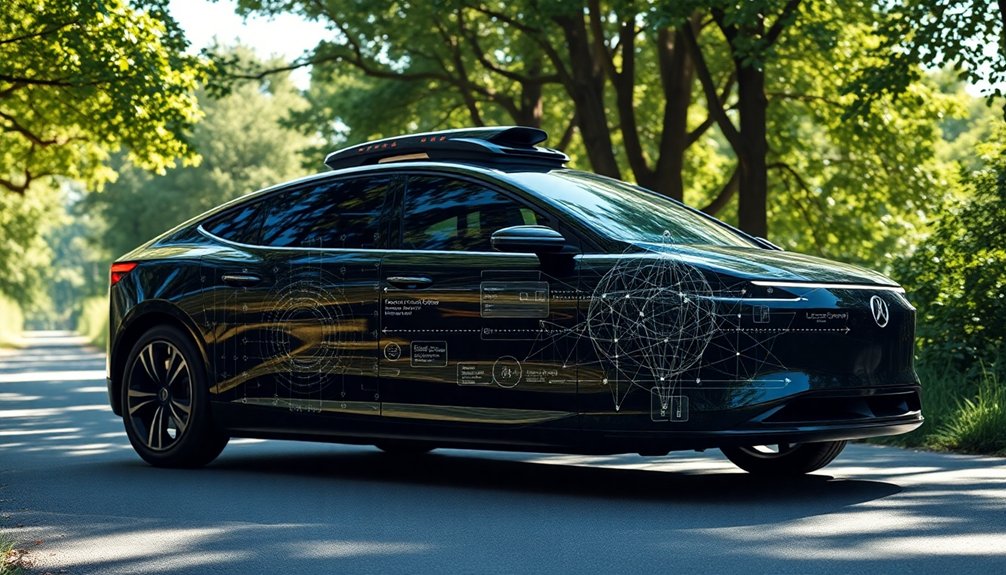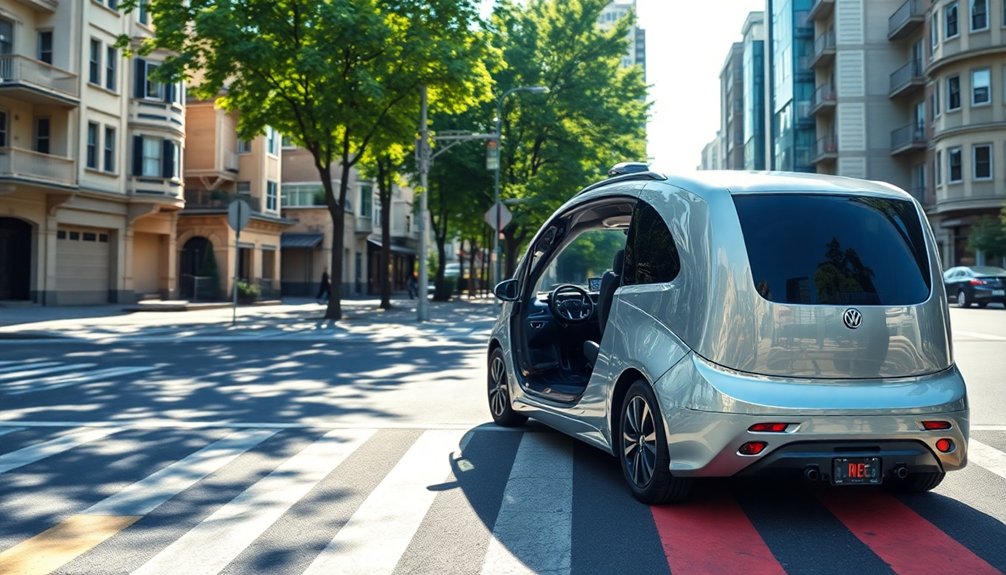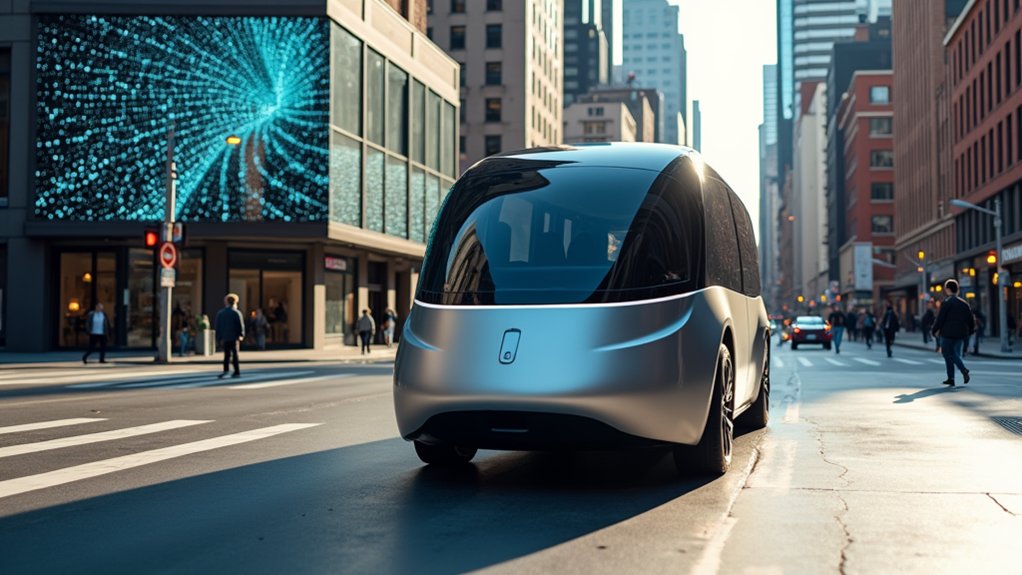The ethical implications of AI in autonomous vehicles challenge you to think critically about safety, accountability, and fairness. You're faced with complex dilemmas where algorithms must decide between passenger safety and the welfare of pedestrians. Different ethical frameworks, like utilitarianism and deontology, influence these decisions, but biases can lead to unfair treatment of certain demographics. The need for human oversight adds another layer of responsibility, ensuring transparency and trust in technology. As the landscape evolves, it's essential to explore how societal values shape these algorithms and what that means for the future of transportation. Discover more about these important issues.
Key Takeaways
- Ethical frameworks, such as utilitarianism and deontology, guide decision-making for AVs, impacting real-time choices between passenger and pedestrian safety.
- Bias in algorithmic design can lead to unequal treatment of different demographic groups, raising concerns about fairness and social equity in AV systems.
- The accountability of manufacturers and the need for human oversight are crucial for ensuring safety and ethical compliance in autonomous vehicles.
- Job displacement in the driving sector due to AVs may exacerbate socioeconomic inequalities, highlighting the need for equitable access to new opportunities.
- Environmental sustainability of AVs is a pressing concern, requiring advancements in hardware efficiency and reliance on clean energy to mitigate emissions.
Ethical Dilemmas in Decision-Making
When it comes to autonomous vehicles, ethical dilemmas in decision-making can feel overwhelming.
You'll often grapple with frameworks like utilitarianism, which aims to maximize overall good, versus deontology, which prioritizes rules regardless of outcomes. For instance, you might face scenarios where the vehicle must choose between the safety of its passengers and pedestrians.
Algorithms need to reflect these moral principles while adapting to real-time data, highlighting the tension between minimizing harm and adhering to ethical duties. Regulatory frameworks play a crucial role in shaping how these ethical considerations are implemented in practice, ensuring that decision-making aligns with established guidelines.
Cultural variations further complicate matters, as moral judgments differ greatly across societies.
Ultimately, ensuring that the vehicle's decision-making aligns with societal values is essential to steering through these ethical challenges effectively.

Safety and Compliance Standards
Safety and compliance standards for autonomous vehicles (AVs) are critical to ensuring their safe integration into public roads. The National Highway Traffic Safety Administration (NHTSA) oversees AV safety, enforcing compliance with federal motor vehicle safety standards.
Even without specific AV regulations, guidelines like the *Federal Automated Vehicles Policy* outline how AVs should handle technology failures and protect passenger privacy. States also enforce regulations, requiring AVs to achieve a minimal risk condition during system failures. Currently, 34 states have some form of AV statute established, which indicates a growing framework for AV regulation.
Manufacturers must certify their AVs meet federal standards and include certification labels. Standards like ANSI/UL 4600 evaluate safety, focusing on hardware and software reliability.
Continuous data collection is essential for evaluating and enhancing AV safety performance, ensuring public confidence in these technologies.
Human Oversight Mechanisms

Human oversight mechanisms are essential for ensuring the safe operation of autonomous vehicles (AVs) in real-world scenarios.
You'll want to know that human involvement is vital in various ways:
- Protecting lives: Algorithms must prioritize human safety above all else.
- Maintaining comfort: AVs should navigate with the same care you'd expect from a human driver.
- Ensuring accountability: Someone needs to oversee the automated systems' decisions, especially given the difficulties in establishing fault in automated vehicle accidents.
- Enhancing reliability: Traffic management systems help guide AVs in complex situations.
- Facilitating transparency: Integrated frameworks clarify how humans and machines interact.
Social Impacts of Automation
Autonomous vehicles (AVs) frequently reshape the social landscape, impacting how we work, live, and interact. You might see job elimination, particularly in driving professions, with an estimated 1.3 to 2.3 million jobs at risk over the next thirty years. While significant losses won't hit until the late 2030s, the annual unemployment rate may rise by 0.1%. However, AVs also promise new job opportunities in manufacturing and maintenance, often offering high-paying roles accessible to those without a degree.
On the flip side, AVs could exacerbate socioeconomic inequality, particularly in access and costs. As AVs change urban planning and public transport dynamics, it's crucial to guarantee equitable benefits for all, preventing further disparities in transportation access. Additionally, the integration of AVs could lead to changes to urban land use, freeing up valuable urban land that can be repurposed for community needs.

Environmental Considerations

As automation reshapes our social structures, it also brings significant environmental considerations into the spotlight.
The rise of autonomous vehicles raises questions about energy consumption and emissions. You'll want to think about:
- The potential emissions equivalent to all the world's data centers.
- A billion autonomous cars could produce over 200 million tonnes of CO2 annually.
- The urgent need for hardware efficiency to double faster than every 1.1 years.
- The sustainability of electric vehicles heavily relies on clean energy sources.
- The stark contrast in emissions compared to fossil fuel-powered vehicles.
In fact, significant improvements in hardware efficiency are necessary to mitigate emissions as we move forward.
While autonomous vehicles might still emit less than traditional cars, the environmental impact is complex and demands careful consideration as we navigate toward a more automated future.
Transparency in AI Processes
In an era where technology shapes our daily lives, transparency in AI processes for autonomous vehicles is more critical than ever. You need to understand how these vehicles make decisions, especially in tense situations like accident avoidance.
When AI processes are transparent, it fosters trust and confidence, ensuring you feel safe while using these technologies. Techniques like feature visualization and local explanations help clarify which factors influence decisions. Additionally, safety standards set forth by organizations like NHTSA and IIHS play a significant role in ensuring that manufacturers prioritize transparency in their AI systems.
Additionally, regulatory frameworks demand that manufacturers uphold transparency, aligning AI actions with human ethics and legal standards. By enhancing visibility into decision-making, you can better comprehend and trust the technology, making it easier to accept autonomous vehicles as a reliable part of your daily commute.
Accountability in Autonomous Systems

While traversing the complex landscape of accountability in autonomous systems, it's essential to recognize who bears responsibility for decisions made by these vehicles.
As the technology evolves, so do the questions surrounding liability and oversight. You may find yourself wondering about the implications of these autonomous decisions:
- Who's liable when an accident occurs?
- Can human operators effectively intervene in emergencies?
- What happens if the technology fails?
- Are manufacturers truly accountable for their creations?
- How will regulatory frameworks evolve to protect consumers?
Understanding these issues is significant, as they shape both public trust and the future of autonomous vehicles. Moreover, with the potential for a 90% reduction in crashes, the stakes surrounding accountability and safety become even more critical.
As accountability mechanisms develop, you'll want to stay informed about your rights and the responsibilities of those who create and operate these systems.

Ethical Frameworks in Algorithms
Understanding accountability leads to a closer examination of how ethical frameworks shape the algorithms driving autonomous vehicles.
These frameworks guide decision-making processes, incorporating principles like utilitarianism, which focuses on maximizing overall well-being, and deontology, emphasizing adherence to moral duties regardless of outcomes. The development of an ethical algorithm further highlights the necessity for frameworks that can evaluate risks effectively while making real-time decisions.
Virtue ethics further influences algorithms by reflecting moral character traits that a virtuous agent would exhibit. Some algorithms adopt hybrid approaches, blending these ethical theories to navigate complex scenarios.
Additionally, data-driven frameworks guarantee that AI learns from various human behaviors and ethical preferences, while real-time decision-making capabilities allow for quick assessments of risks and outcomes.
Fairness and Equity Principles

Fairness and equity principles are essential for the ethical deployment of autonomous vehicles, ensuring all road users are treated justly. You must recognize that biases in detection and decision-making can lead to serious consequences.
Consider the potential impacts:
- Higher detection accuracy for white pedestrians over Black pedestrians.
- Age-related biases, where adults are 20.14% less likely to be detected than children.
- Marginalized groups facing increased risks from unfair algorithms.
- The perpetuation of existing social inequalities through biased data.
- Erosion of trust in autonomous technology if fairness isn't prioritized. Additionally, higher detection accuracy has been observed for white pedestrians compared to other ethnicities, highlighting the need for urgent attention to fairness in autonomous systems.
Cultural Perspectives on Ethics
Cultural perspectives on ethics greatly shape how autonomous vehicles (AVs) are designed and programmed. Different cultures have unique moral preferences; for instance, in individualistic societies like the US, AVs may prioritize the driver's life, while in long-term oriented cultures, such as Japan, the focus might be on protecting the young. Ethical relativism suggests that AVs should adhere to local norms, reflecting the society they operate within. This includes abiding by local laws and considering the owner's morals, as a one-size-fits-all approach isn't acceptable. Furthermore, incorporating cultural philosophies, like Buddhist compassion, can further align AV decisions with societal values. Training algorithms to reflect these perspectives guarantees that AVs make ethically sound choices in diverse cultural contexts. Additionally, the legal responsibility in the event of an accident further complicates ethical programming, as it introduces a layer of accountability that varies by region.

Frequently Asked Questions
How Do Autonomous Vehicles Handle Unexpected Road Conditions?
Autonomous vehicles handle unexpected road conditions by relying on advanced sensor technology and real-time data.
When you encounter an obstacle, the vehicle's sensors detect it and assess the situation. If it's an unusual object, the system may struggle, but connected vehicle data can help enhance its awareness.
What Happens if an Autonomous Vehicle Is Hacked?
What would you do if your self-driving car suddenly acted against your commands?
If an autonomous vehicle gets hacked, critical systems can fail, leading to dangerous malfunctions like loss of braking or steering control.
Hackers could even take over the vehicle remotely, putting you and others at risk.
Additionally, your personal data might be stolen, leading to privacy violations.
The consequences of such breaches could be severe, affecting both safety and security on the road.
Can Autonomous Vehicles Learn From Real-Time Experiences?
Yes, autonomous vehicles can learn from real-time experiences. They use advanced sensors to gather data about their surroundings, allowing them to respond quickly to changing conditions.
Through continuous feedback, these vehicles adapt their driving behaviors by recognizing patterns and anomalies. This learning process enables them to handle various scenarios effectively, improving their performance over time.
How Are Ethical Dilemmas Communicated to Passengers?
Communicating ethical dilemmas to you is like explaining a complex recipe: every ingredient matters.
Before your journey, you might set your ethical preferences, allowing the vehicle to align with your values.
As you ride, clear explanations of decisions enhance your understanding, building trust.
Educational materials can prepare you for potential dilemmas, while feedback options let you voice concerns.
This ongoing dialogue guarantees your comfort and awareness in steering through ethical choices on the road.
What Role Do Insurance Companies Play With Autonomous Vehicles?
Insurance companies play an essential role in the world of autonomous vehicles.
They'll need to adapt policies to cover new risks, like technology errors and cyber liabilities. As responsibility shifts from drivers to manufacturers, you might see changes in coverage requirements, affecting your premiums.
If you own an autonomous vehicle, you could benefit from lower rates due to fewer accidents, while human-controlled drivers might face increased costs as the market evolves.





